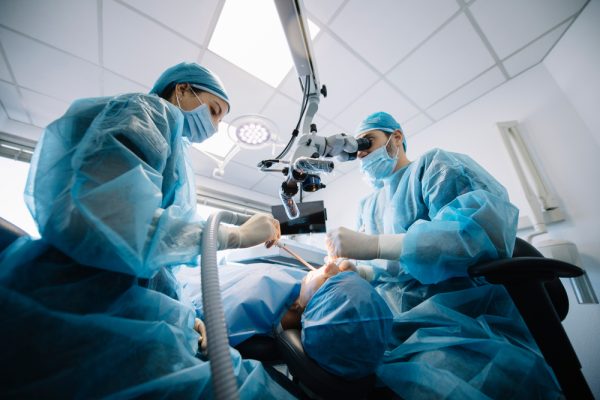What Is Oral Cancer?
Oral cancer is a type of cancer that develops in the tissues of the mouth, including the lips, tongue, cheeks, gums, and the roof and floor of the mouth. It often starts as a small, painless lump or a sore but can quickly grow and spread when not treated promptly.
If you’re experiencing any early symptoms of oral cancer, such as red or white patches in the mouth, contact our dentist in Seattle to schedule an oral cancer screening. From Green Lake to Fremont, patients trust our Seattle dentist for top-quality treatments and personalized care for the whole family.
Risk Factors
Risk factors for oral cancer include:
- Tobacco use
- Alcohol consumption
- HPV infection
- Inadequate oral hygiene
To reduce the risk of oral cancer, it’s recommended to:
- Abstain from tobacco use
- Limit or abstain from alcohol consumption
- Increase fruit and vegetable intake
- Manage stress levels
- Engage in regular physical activity

Surgical Approaches to Oral Cancer
Surgical approaches play a pivotal role in the treatment of oral cancer. There are three main surgical methods:
- Tumor removal
- Lymph node dissection
- Reconstructive surgery
Tumor Removal
Tumor removal, or tumor resection, is a primary treatment option for oral cancer. The goal of this surgical procedure is to remove the entire tumor and some surrounding tissue, eradicating the cancerous or benign tumor from the body.
The techniques used for tumor removal involve making an incision larger than that used for a biopsy and removing the tumor as well as some adjacent healthy tissue. This method comes with potential risks such as infection, bleeding, and damage to surrounding tissue.
Lymph Node Dissection
Lymph node dissection, also known as lymphadenectomy, is a surgical procedure in which lymph nodes are carefully dissected and removed. This procedure is typically performed to remove lymph nodes that may contain cancer cells.
In the case of oral cavity cancer treatment, lymph node dissection may be necessary to evaluate the extent of cancer spread and to remove affected nodes. Identifying and excising cancerous lymph nodes aids in a more accurate assessment of the disease scope and customizing the treatment plan accordingly.
Reconstructive Surgery
Reconstructive surgery plays a crucial role in restoring appearance and function after tumor removal and lymph node dissection. This surgical procedure is designed to treat body parts that have been impacted aesthetically or functionally due to:
- Congenital defects
- Developmental abnormalities
- Trauma
- Disease
Common reconstructive surgery procedures include:
- Skin grafts
- Tissue expansion
- Flap surgery
- Bone grafts

Radiation Therapy Techniques
Radiation therapy techniques utilize high doses of radiation to destroy cancer cells and reduce tumor size. Three main radiation therapy techniques are external beam radiation therapy, intensity-modulated radiation therapy, and proton therapy.
The choice of technique depends on factors such as the stage of cancer, the patient’s general health, and the availability of resources.
External Beam Radiation Therapy
External beam radiation therapy is a type of radiation therapy that utilizes high-energy beams to precisely target and eliminate cancer cells. This therapy operates by using a machine to deliver high-energy radiation to the cancer cells, disrupting their ability to grow and divide.
The advantages of external beam radiation therapy include its ability to treat cancer that has metastasized to other parts of the body, and its use in reducing tumor sizes before surgery. However, it also carries potential risks such as skin irritation, fatigue, and an increased risk of developing secondary cancers.
Intensity Modulated Radiation Therapy
Intensity-modulated radiation therapy (IMRT) uses computer-controlled X-ray accelerators to administer precise doses of radiation to a tumor. This therapy allows for more accurate targeting of cancer cells while minimizing harm to adjacent healthy tissue.
IMRT offers increased accuracy of cancer cell targeting, reduced side effects, and enhanced results. However, it may also result in an increased risk of radiation-induced side effects, including skin irritation, fatigue, and nausea.
Proton Therapy
Proton therapy is a newer form of radiation therapy that uses protons instead of X-rays to treat cancer. This therapy offers several advantages:
- It delivers a high concentration of energy accurately to the specified area, minimizing damage to surrounding healthy tissues.
- It’s a non-invasive treatment option, meaning that it does not require surgery.
- It’s highly precise, allowing for targeted treatment of tumors while minimizing side effects.
The primary benefit of proton therapy is its accuracy, as the protons can be accurately directed to the exact area of the tumor, minimizing the risk of harm to healthy tissue and organs. However, there are some drawbacks to consider:
- Proton therapy is more expensive than conventional radiation therapy.
- Proton therapy is not available in all locations.
- Since proton therapy is a relatively new form of radiation therapy, there is currently limited data on its long-term effects.
Medication-Based Therapies
Chemotherapy
Chemotherapy is a medication-based therapy that uses drugs to kill cancer cells. It can be administered orally, intravenously, or topically, and may be used in conjunction with other treatments such as radiation therapy or surgery.
The advantages of chemotherapy include its ability to destroy cancer cells and inhibit tumor growth, while the potential risks include nausea, vomiting, hair loss, fatigue, and an increased risk of infection.
Targeted Therapy
Targeted therapy is another medication-based therapy that specifically targets genes and proteins in cancer cells, inhibiting their growth and survival. One example of targeted therapy for mouth cancer is cetuximab, which works by inhibiting the action of a protein present in many healthy cells but more concentrated in certain cancer cells.
The advantages of targeted therapy include its ability to specifically target cancer cells with fewer side effects than chemotherapy. However, other targeted drugs may be considered only if standard treatments are not effective.
Immunotherapy
Immunotherapy is a form of treatment that utilizes the body’s immune system to combat cancer cells. This therapy, typically reserved for advanced cases, stimulates the immune system to recognize and attack cancer cells, either by targeting specific cancer cells or by enhancing the body’s overall immune response.
The types of immunotherapy available include:
- Monoclonal antibodies
- Checkpoint inhibitors
- Adoptive cell transfer
- Cytokine therapy
While immunotherapy offers the advantage of harnessing the body’s natural defenses to fight cancer, it can also result in side effects such as fatigue, nausea, vomiting, diarrhea, and skin rash.

The Role of Palliative Care
Pain Management
Pain management is an essential aspect of palliative care, helping patients cope with the physical discomfort associated with cancer and its treatments. Pain management options include:
- Medications
- Physical therapy
- Psychological therapy
- Alternative therapies
Effective pain management can significantly improve a patient’s quality of life by diminishing pain and discomfort. However, certain pain management techniques may also be associated with side effects such as nausea, fatigue, and constipation.
Nutritional Support
Nutritional support ensures patients maintain a healthy diet and receive adequate nourishment during treatment. Nutritional support options include dietary counseling, nutritional supplements, and enteral or parenteral nutrition.
By addressing the nutritional needs of oral cancer patients, palliative care can help reduce the likelihood of malnutrition and other complications related to cancer treatment. However, nutritional support also comes with potential risks such as over- or under-nutrition and the possibility of infection from enteral or parenteral nutrition.
Emotional Support
Emotional support, including counseling and support groups, helps patients and their families cope with the psychological challenges of cancer. Some benefits of emotional support for oral cancer patients include:
- Coping with depression and anxiety
- Finding a sense of community and understanding
- Learning effective coping strategies
- Gaining emotional resilience and strength
Resources for emotional support may include consultations with social workers and participation in support groups. By addressing the emotional needs of oral cancer patients, palliative care can provide a sense of comfort and optimism during a challenging time.
Participation in Clinical Trials
Participation in clinical trials may provide access to new and experimental treatments for oral cancer patients. Clinical trials offer the opportunity to access novel therapies that may not be available through standard care and provide researchers with the ability to assess the safety and efficacy of new treatments.
Frequently Asked Questions
Oral cancer can be cured if it’s found and treated early enough. The good news is that a healthcare provider or dentist can often detect it in its early stages due to the ease of examining the mouth and lips.
On average, it can take anywhere from a few weeks to several months for oral cancer to spread, depending on the type and stage of the tumor and the patient’s health.
Schedule an Oral Cancer Screening Today!
Get ahead of oral cancer by getting an early diagnosis. If you’re overdue for a dental cleaning and oral cancer exam, contact our Seattle dentist today by calling (206) 682-3888 to schedule your appointment.

